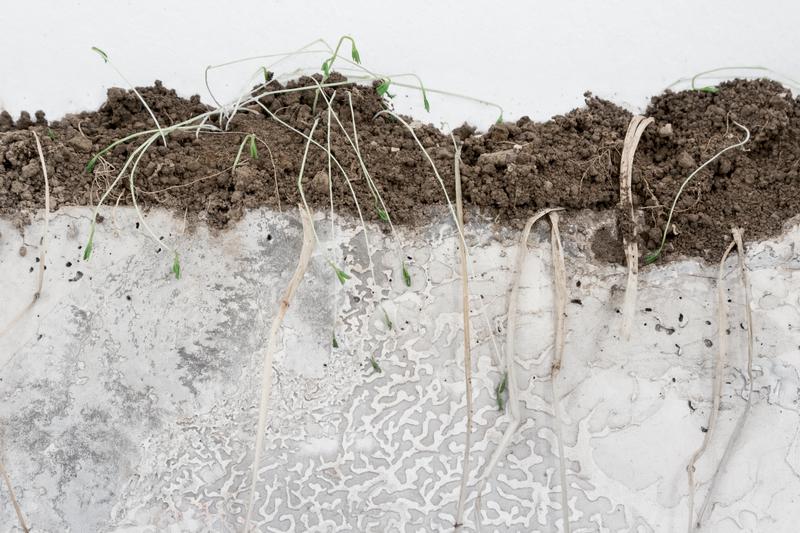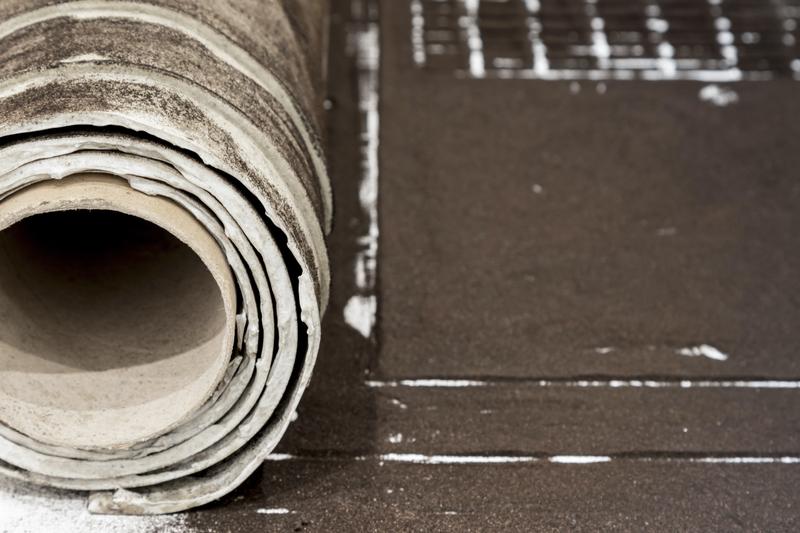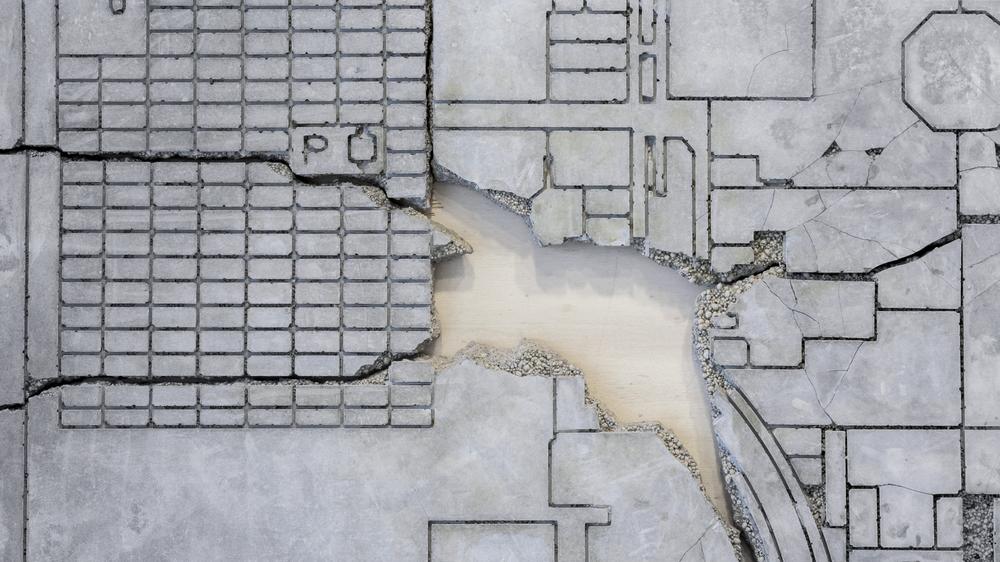Andrea Francolino
Principi di mutamento11 October ︎︎︎ 30 Novembre 2018
di Jessica Bianchera
Eco – etico e concreto, “Econcrethic”, come lui stesso lo definisce, è il lavoro di Andrea Francolino (Bari, 1979), artista invitato da Spazio Cordis per una personale che ne inaugura l’attività espositiva. La sua ricerca, aperta a contaminazioni con altri ambiti come la fisica e la sociologia, si fonda sull’idea di un labile e necessario equilibrio tra artificiale e naturale, uomo e mondo, decadimento e rinascita, ordine e caos, partendo da una considerazione che è insieme interrogativo esistenziale: “perché il legame dell’uomo con la natura diminuisce conseguentemente e proporzionalmente a una sua maggiore evoluzione materialista?”. Di qui la sua attenzione si sposta continuamente dall’infinitamente piccolo all’infinitamente grande, dall’apparente semplicità di una pianta all’estrema complessità del cosmo per svolgere un’indagine sui rapporti, gli equilibri, le iterazioni possibili tra le “cose dell’uomo” e “le cose di natura”. A fare da filo conduttore, una latente componente di casualità come dimensione insita nell’ordine stesso del cosmo. Una casualità scoperta e rilevata (com’è il caso delle crepe), studiata e osservata (come nelle piante), incontrata e analizzata (come accade nei vetri di Caso x caos x infinite variabili, progetto presentato a maggio presso The Open Box, Milano).
Andrea Francolino (Bari, 1979), maker of what he defines as eco-ethical and concrete, or “Econcrethic” art, has been invited to participate with a solo show at the launch of a new exhibition space, Spazio Cordis. Francolino’s artistic search, which is open to contamination from other disciplines such as physics and sociology, is grounded in the notion of a fleeting and necessary balance between the artificial and the natural, man and the world, decay and rebirth, order and chaos, starting from a consideration that is at the same time an existential question: "Why does man's bond with Nature decrease consequently and proportionally to the growth of his materialistic evolution?” Francolino’s focus shifts constantly from the infinitely small to the infinitely large, from the apparent simplicity of a plant to the extreme complexity of the cosmos, as he investigates the relationships, balances, and possible iterations between the “things of man” and the “things of Nature”. The common thread is a latent component of randomness — a dimension inherent to the very order of the cosmos. A randomness that is discovered and detected (as in the case of cracks), studied and observed (as in plants), met and analysed (as in the glass elements of Case x Chaos x Infinite Variables, a project that was presented in May at The Open Box in Milan).
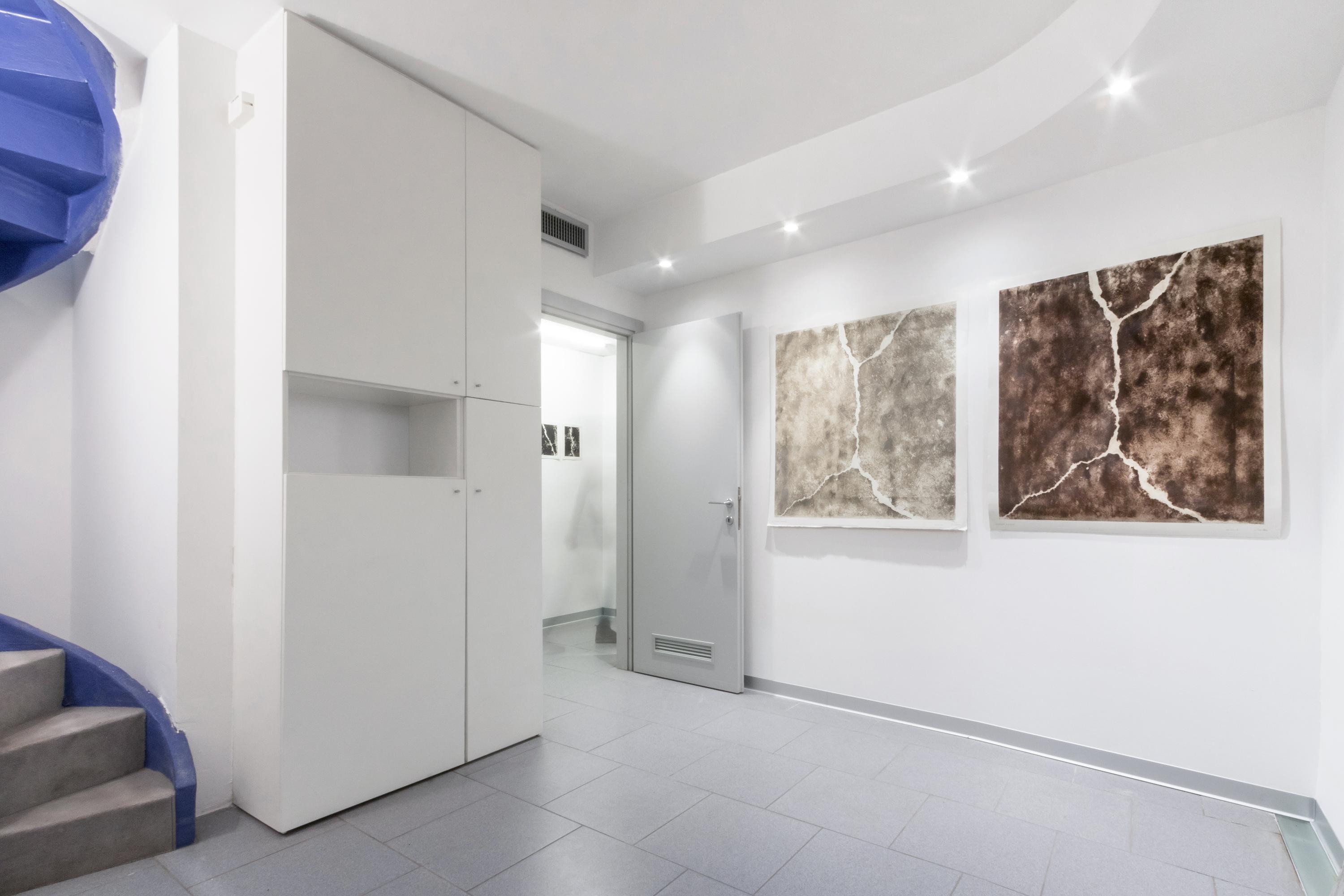
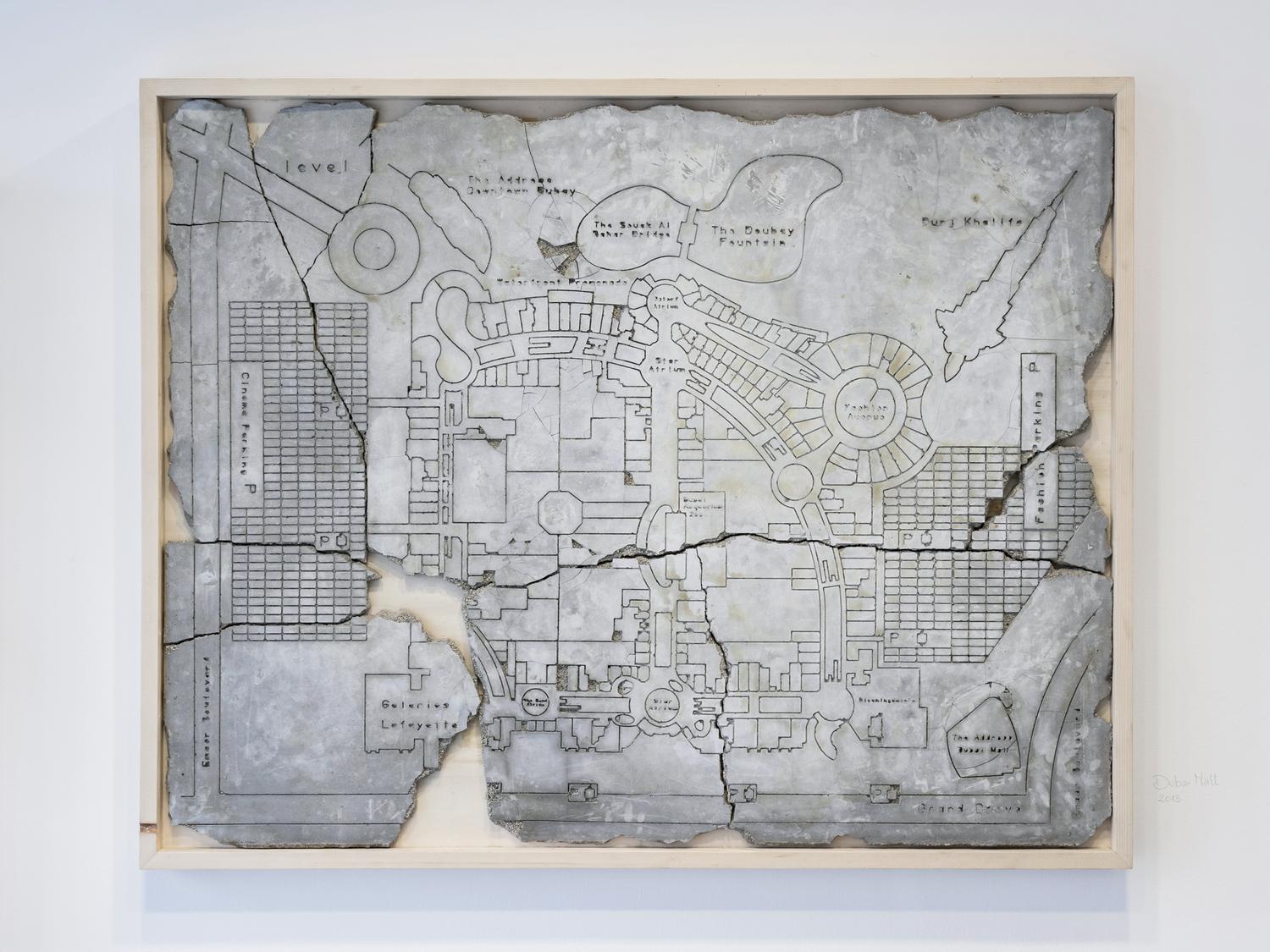
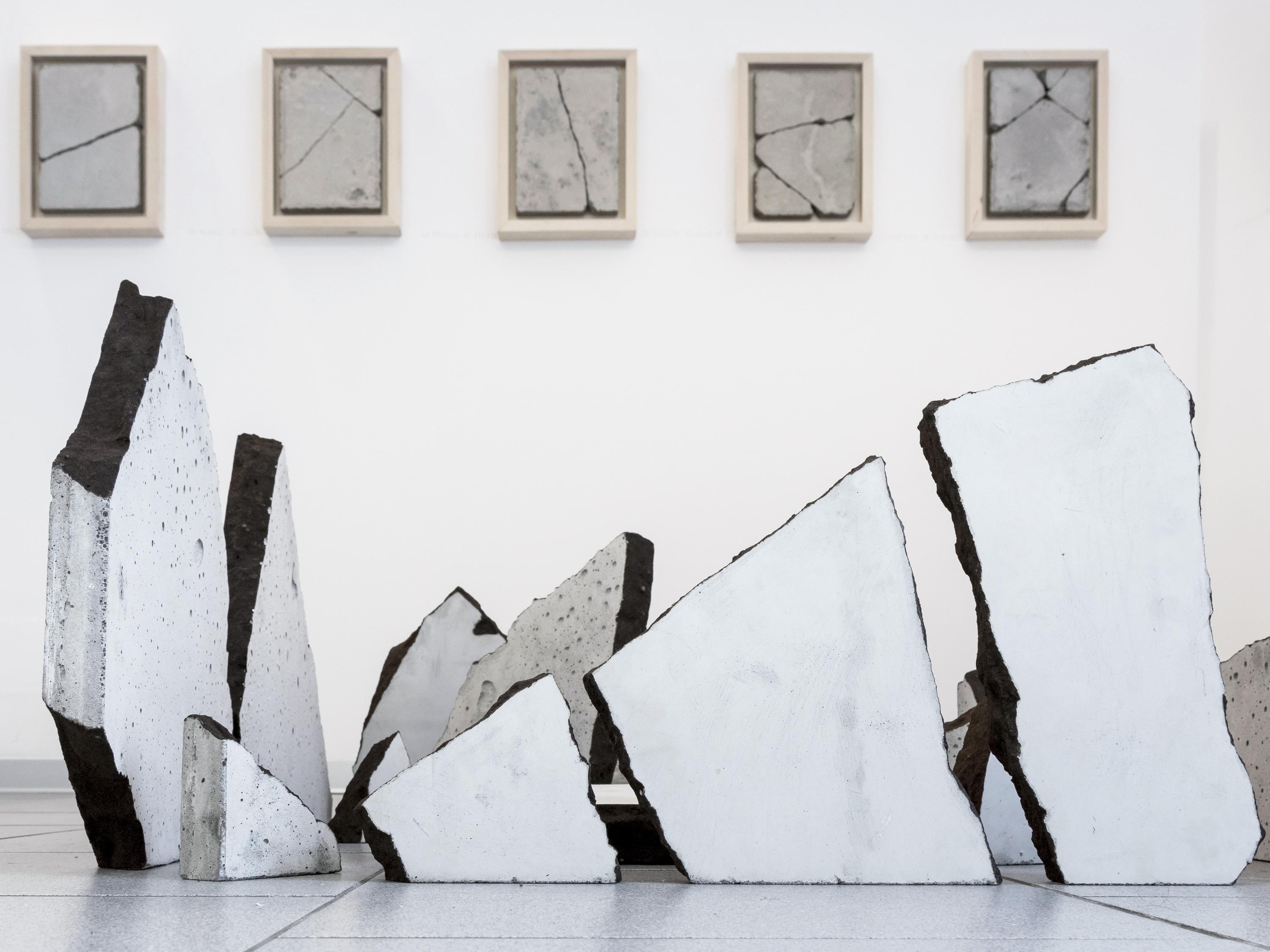
Partendo da questi presupposti teorici e concreti, per Principi di mutamento abbiamo selezionato lavori – alcuni dei quali inediti – che declinano il paradigma di un passaggio dalla matericità piena alla polvere, alludendo a un ritmo congenito e necessario della natura in cui però, di volta in volta, negli episodi singoli, l’avanzata dell’uomo si confronta con la forza di riappropriazione dell’ambiente. A questo proposito, è importante rilevare come l’atteggiamento dell’artista nello svolgere il tema del rapporto uomo-natura non scada in una mera polemica contro la
cementificazione degli spazi naturali o nell’affermazione di un auspicabile ritorno alla terra: la sua ricerca infatti è quella di un equilibrio perfetto, che colloca l’uomo – così com’è, con i suoi bisogni materiali – in un rapporto alla pari con la natura, come fossero entrambi ingredienti necessari in dosi paritarie nella formula di un’esistenza completa e sostenibile. La natura diventa così elemento indispensabile all’uomo tanto quanto quest’ultimo lo è nei suoi confronti. La mostra apre con Dubai Mall (2013), icnografia in calcestruzzo costruita, distrutta e ricostruita di uno degli innumerevoli simboli della contemporanea società del consumo al massimo del suo edonismo e si chiude con la sua labile impronta in una variante inedita dell’opera, realizzata appositamente per Spazio Cordis, la quale prevede l’utilizzo di polvere di terra anziché polvere di cemento. Questi due lavori, che non a caso contengono il principio e la fine dello sviluppo espositivo in un percorso biunivoco esperibile anche a ritroso, introducono diversi elementi chiave per leggere la mostra e accedere a una più vasta comprensione della ricerca di Francolino. In primis i materiali: cemento e terra, che ritornano in ogni lavoro, diventano gli emblemi della dicotomia tra artificiale e naturale, uomo e ambiente. In secondo luogo, l’alternanza (che poi si fa coesistenza) della crepa e della polvere, entrambi temi e strumenti fondamentali nel lavoro dell’artista: una in quanto elemento causale e incontrollabile, metafora concettuale dell’esistenza, del trascorrere del tempo, del mutamento come principio endogeno alla vita del nostro pianeta; l’altra, come stato ineluttabile, conclusione e rinascita di un ciclo perpetuo, incontrastabile e necessario. Così la crepa ritorna nella doppia serie delle Sette meraviglie del mondo (2013/2015), divise tra mondo antico e mondo moderno, ma in ultima analisi indistinguibili: la natura interviene senza distinzione nel suo
processo di riappropriazione, svelando la fragilità dell’essere umano e delle sue “creazioni”, per divenire poi principio unificante ed egualitario, trasversale alla linea del tempo. Unico indizio utile all’identificazione sono le coordinate spaziali che geolocalizzano ognuna delle crepe. Francolino sceglie di titolare i singoli pezzi utilizzando queste stringhe di numeri e simboli che secondo un sistema interamente ideato dall’uomo e regolamentato secondo convenzione sociale, identificano esattamente un luogo, una porzione di mondo. Non solo per l’uso del cemento, quindi, ma anche nel rapporto titolo-opera, si realizza la dicotomia e l’equilibrio tra l’artificiale - la razionalità incasellatrice umana (peraltro veicolata da uno strumento tecnologico utile alla geolocalizazione) – e il naturale - la crepa.
cementificazione degli spazi naturali o nell’affermazione di un auspicabile ritorno alla terra: la sua ricerca infatti è quella di un equilibrio perfetto, che colloca l’uomo – così com’è, con i suoi bisogni materiali – in un rapporto alla pari con la natura, come fossero entrambi ingredienti necessari in dosi paritarie nella formula di un’esistenza completa e sostenibile. La natura diventa così elemento indispensabile all’uomo tanto quanto quest’ultimo lo è nei suoi confronti. La mostra apre con Dubai Mall (2013), icnografia in calcestruzzo costruita, distrutta e ricostruita di uno degli innumerevoli simboli della contemporanea società del consumo al massimo del suo edonismo e si chiude con la sua labile impronta in una variante inedita dell’opera, realizzata appositamente per Spazio Cordis, la quale prevede l’utilizzo di polvere di terra anziché polvere di cemento. Questi due lavori, che non a caso contengono il principio e la fine dello sviluppo espositivo in un percorso biunivoco esperibile anche a ritroso, introducono diversi elementi chiave per leggere la mostra e accedere a una più vasta comprensione della ricerca di Francolino. In primis i materiali: cemento e terra, che ritornano in ogni lavoro, diventano gli emblemi della dicotomia tra artificiale e naturale, uomo e ambiente. In secondo luogo, l’alternanza (che poi si fa coesistenza) della crepa e della polvere, entrambi temi e strumenti fondamentali nel lavoro dell’artista: una in quanto elemento causale e incontrollabile, metafora concettuale dell’esistenza, del trascorrere del tempo, del mutamento come principio endogeno alla vita del nostro pianeta; l’altra, come stato ineluttabile, conclusione e rinascita di un ciclo perpetuo, incontrastabile e necessario. Così la crepa ritorna nella doppia serie delle Sette meraviglie del mondo (2013/2015), divise tra mondo antico e mondo moderno, ma in ultima analisi indistinguibili: la natura interviene senza distinzione nel suo
processo di riappropriazione, svelando la fragilità dell’essere umano e delle sue “creazioni”, per divenire poi principio unificante ed egualitario, trasversale alla linea del tempo. Unico indizio utile all’identificazione sono le coordinate spaziali che geolocalizzano ognuna delle crepe. Francolino sceglie di titolare i singoli pezzi utilizzando queste stringhe di numeri e simboli che secondo un sistema interamente ideato dall’uomo e regolamentato secondo convenzione sociale, identificano esattamente un luogo, una porzione di mondo. Non solo per l’uso del cemento, quindi, ma anche nel rapporto titolo-opera, si realizza la dicotomia e l’equilibrio tra l’artificiale - la razionalità incasellatrice umana (peraltro veicolata da uno strumento tecnologico utile alla geolocalizazione) – e il naturale - la crepa.
Based on these theoretical and concrete premises, for Principles of Change we selected works – some of which are being exhibited here for the first time – that articulate the paradigm of a transition from full materiality to dust, alluding to an intrinsic and necessary rhythm of nature in which, however, from time to time, in individual episodes, the advance of man must confront the re-appropriative force of the environment. In this regard, it is important to note that the artist’s stance in developing the theme of the relationship between man and Nature does not degenerate into a mere argument against
overbuilding in natural spaces, or into a call for a desirable return to the Earth: rather, he is on a quest for a perfect balance, placing man - as he is, with his material needs - in relationship on a par with Nature, as though they were both necessary ingredients whose equal doses make up the formula of a complete and sustainable existence. Thus Nature becomes an indispensable element for man, and vice versa.
The show opens with Dubai Mall(2013), a concrete iconography — built, destroyed, and rebuilt — of one of the countless symbols of contemporary consumer society at its hedonistic maximum, and closes with its ephemeral imprint in an original variation of the piece, made specifically for Spazio Cordis, using earth dust instead of cement powder. These two pieces — which not coincidentally mark the beginning and the end of the exhibition in a two-way path, which can also be experienced backwards — introduce several key elements for the interpretation of the show, allowing viewers access to a broader understanding of Francolino’s research. First of all, the materials: cement and earth, which return in every piece, are an emblem of the dichotomy between the artificial and the natural, man and the environment. Secondly, the alternation (which becomes coexistence) between the crack and the dust, both of which are recurrent themes and key instruments in the artist’s work: the one insofar as it is a causal and uncontrollable element, a conceptual metaphor for existence, for the passage of time, for change as an endogenous principle of the life of our planet; the other, as an unavoidable state, the conclusion and rebirth of a perpetual, incontestable and necessary cycle. So the crack returns in the Seven Wonders of the World (2013/2015) double series, which are divided into the ancient and the modern worlds, but which are ultimately undistinguishable: Nature intervenes without discrimination in its process of re-
appropriation, revealing the fragility of man and his “creations” only to become a unifying and egalitarian principle, which transversally intersects the line of time. The only useful clues to identification are the spatial coordinates that geolocate each of the cracks. Francolino chooses to title the individual pieces by using these sequences of numbers and symbols from an entirely man-made system — one that is regulated by social convention — to precisely identify a place, a portion of the world. So it is not only through the use of cement, but also through the relationship between title and work that the dichotomy and the balance plays out between the artificial — the human, pigeon-holing rationality (conveyed, moreover, through geolocation technology) — and the natural — the crack.
overbuilding in natural spaces, or into a call for a desirable return to the Earth: rather, he is on a quest for a perfect balance, placing man - as he is, with his material needs - in relationship on a par with Nature, as though they were both necessary ingredients whose equal doses make up the formula of a complete and sustainable existence. Thus Nature becomes an indispensable element for man, and vice versa.
The show opens with Dubai Mall(2013), a concrete iconography — built, destroyed, and rebuilt — of one of the countless symbols of contemporary consumer society at its hedonistic maximum, and closes with its ephemeral imprint in an original variation of the piece, made specifically for Spazio Cordis, using earth dust instead of cement powder. These two pieces — which not coincidentally mark the beginning and the end of the exhibition in a two-way path, which can also be experienced backwards — introduce several key elements for the interpretation of the show, allowing viewers access to a broader understanding of Francolino’s research. First of all, the materials: cement and earth, which return in every piece, are an emblem of the dichotomy between the artificial and the natural, man and the environment. Secondly, the alternation (which becomes coexistence) between the crack and the dust, both of which are recurrent themes and key instruments in the artist’s work: the one insofar as it is a causal and uncontrollable element, a conceptual metaphor for existence, for the passage of time, for change as an endogenous principle of the life of our planet; the other, as an unavoidable state, the conclusion and rebirth of a perpetual, incontestable and necessary cycle. So the crack returns in the Seven Wonders of the World (2013/2015) double series, which are divided into the ancient and the modern worlds, but which are ultimately undistinguishable: Nature intervenes without discrimination in its process of re-
appropriation, revealing the fragility of man and his “creations” only to become a unifying and egalitarian principle, which transversally intersects the line of time. The only useful clues to identification are the spatial coordinates that geolocate each of the cracks. Francolino chooses to title the individual pieces by using these sequences of numbers and symbols from an entirely man-made system — one that is regulated by social convention — to precisely identify a place, a portion of the world. So it is not only through the use of cement, but also through the relationship between title and work that the dichotomy and the balance plays out between the artificial — the human, pigeon-holing rationality (conveyed, moreover, through geolocation technology) — and the natural — the crack.
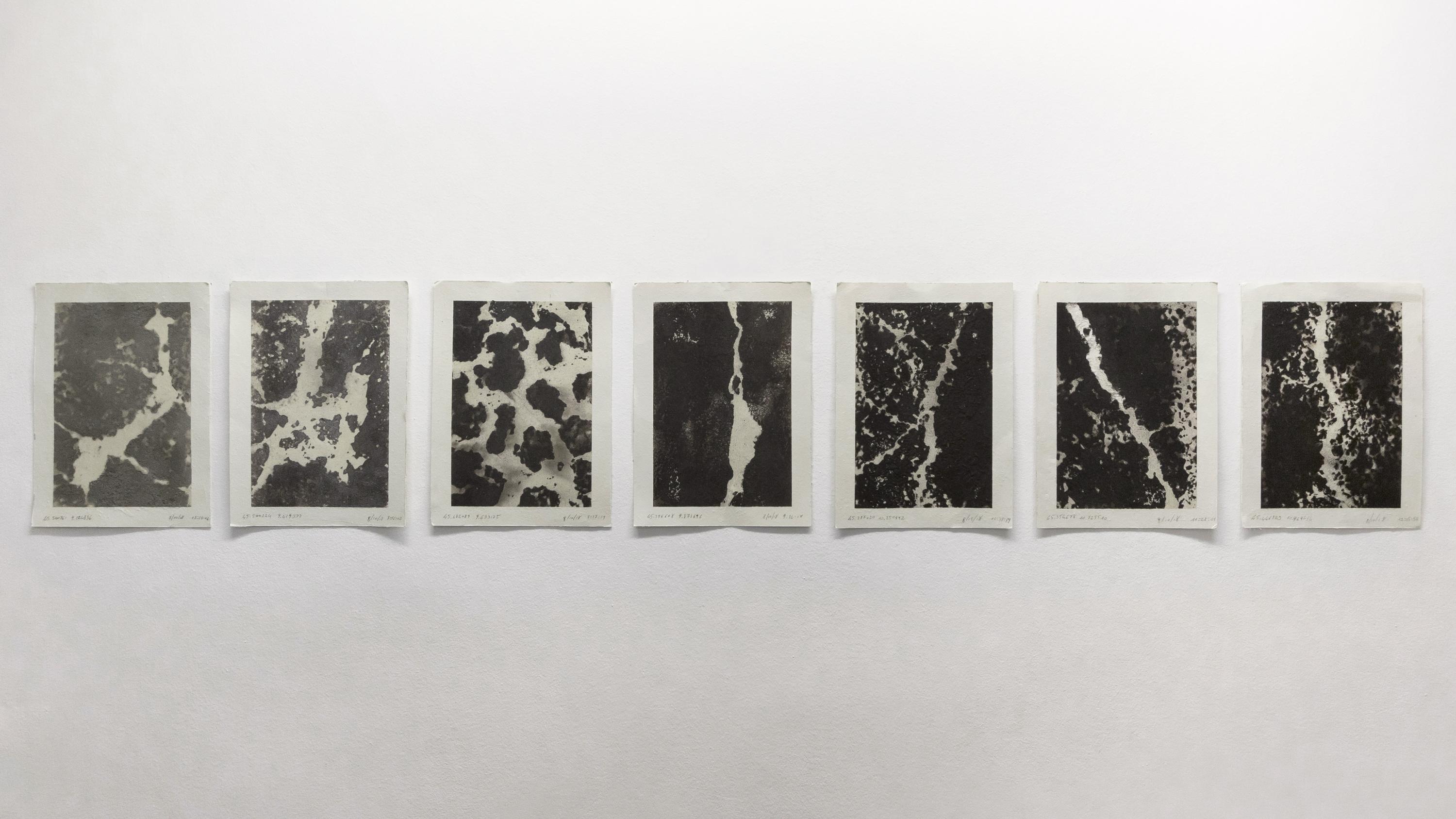
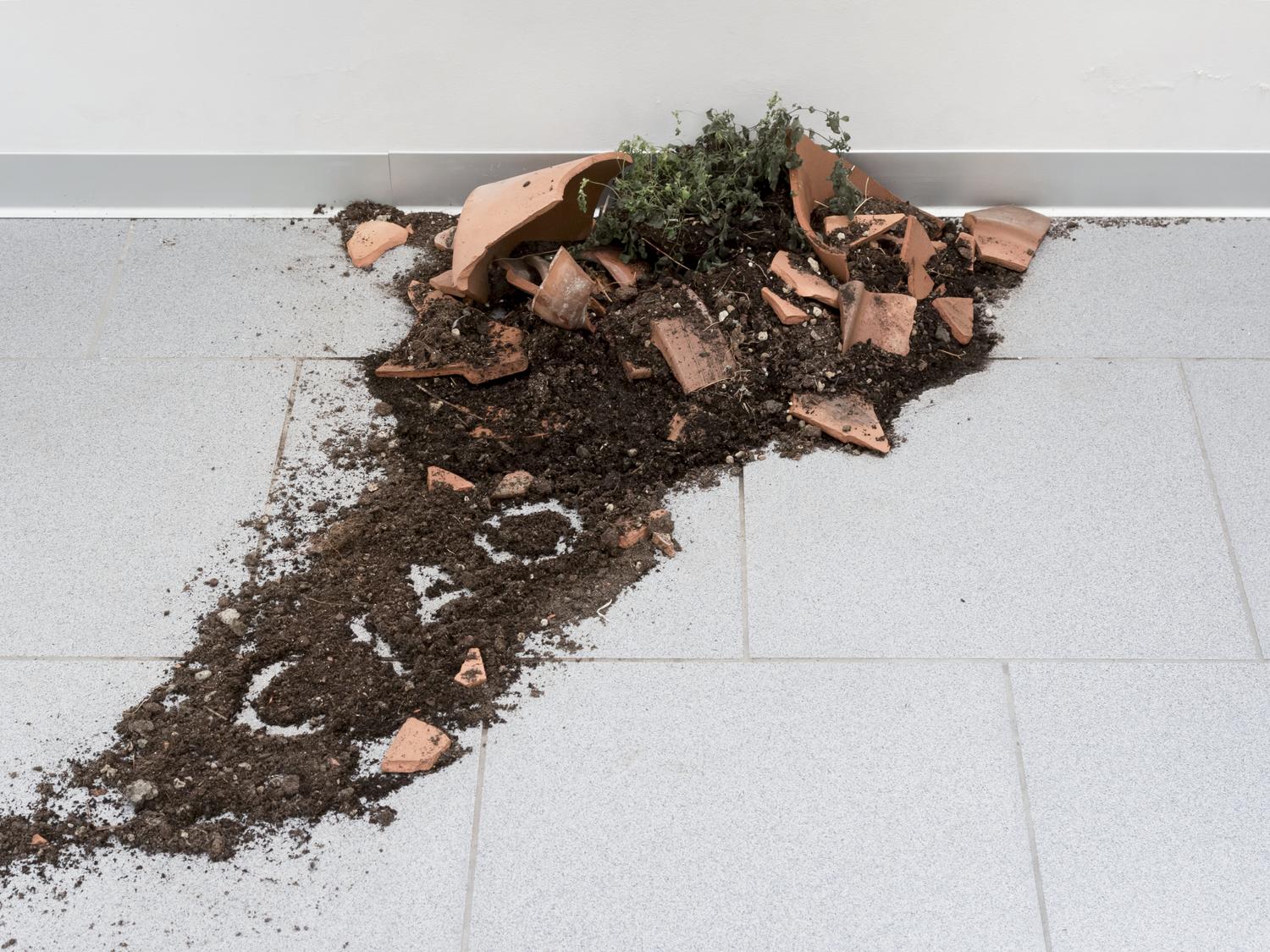
Qualcosa di simile avviene con m² (2016): la razionalità e l’armonia della forma geometrica incontrano la componente casuale della natura laddove un metro quadrato in calcestruzzo viene crepato e destrutturato. Il risultato è una forma esplosa, che se nel perimetro conserva la dimensione originale, all’interno di questo recinto si muove secondo le infinite variabili del caso. A completare il bilanciamento tra i due poli la polvere di terra, utilizzata per rilevare i margini crepati dei frammenti in cemento.
In Dalla terra al cemento alla terra al cemento (2018) poi, fisico e simbolico passaggio dalla matericità piena delle prime sale alla polvere delle opere al piano interrato, ritorna il macrotema del percorso reversibile tra il mondo del cemento – pertinenza dell’uomo – e il mondo della terra – pertinenza della natura-, in una sequenza di sette pezzi realizzati con la polvere dei due materiali, puri agli antipodi e gradatamente miscelati nella transizione. Qualcosa di simile avviene in From 45.500761 9.224836 to 45.446823 10.969234 (2018) con la differenza che intervengono qui anche la crepa e le coordinate geografiche: si tratta infatti di una sequenza di crepe rilevate in polvere di cemento recuperato e in polvere di terra lungo il percorso da Milano, dov’è il suo studio, a Verona, sede della mostra. Qui l’intervento dell’uomo si limita all’atteggiamento catalogatore, alla cura dell’artista, che con fare scientifico preleva l’impronta di un selezionato numero di crepe incontrate sul suo tragitto e registra l’atto annotando coordinata geografica, data e ora. E se nel dittico 45.891389 9.767435 (2016) si completa lo stato di equilibrio presentando il rilievo della stessa crepa in polvere di cemento prima e in polvere di terra poi, la natura si fa sempre più presente in opere come m² 2016 e Mater (2016): nella prima freschi germogli fioriscono da un metro quadrato in calcestruzzo inerte, nella seconda una piccola pianta prosegue il suo ciclo di vita tra i cocci di un vaso rotto che qualcuno ha spazzato da un lato. In questi ultimi casi è la natura a dimostrare resistenza e fragilità allo stesso tempo, poiché il suo saper rifiorire dalle macerie necessiterà della cura di chi conserva l’opera, a sottolineare quanto in un sistema perfetto l’uomo debba partecipare alla vita del cosmo agendo in equilibrio con quei “principi di mutamento” universali e unici, inalterabili e variabili, identici e contrari. Ragionando per dicotomie e con un linguaggio estremamente pulito ed essenziale, Francolino rende manifesta ogni riflessione esistenziale che ha portato alla realizzazione dei suoi lavori, ammettendo allo stesso tempo qualsiasi possibile considerazione successiva. Terra e cemento, crepa e germoglio, la studiata associazione degli opposti e l’attenta osservazione delle componenti casuali.
In Dalla terra al cemento alla terra al cemento (2018) poi, fisico e simbolico passaggio dalla matericità piena delle prime sale alla polvere delle opere al piano interrato, ritorna il macrotema del percorso reversibile tra il mondo del cemento – pertinenza dell’uomo – e il mondo della terra – pertinenza della natura-, in una sequenza di sette pezzi realizzati con la polvere dei due materiali, puri agli antipodi e gradatamente miscelati nella transizione. Qualcosa di simile avviene in From 45.500761 9.224836 to 45.446823 10.969234 (2018) con la differenza che intervengono qui anche la crepa e le coordinate geografiche: si tratta infatti di una sequenza di crepe rilevate in polvere di cemento recuperato e in polvere di terra lungo il percorso da Milano, dov’è il suo studio, a Verona, sede della mostra. Qui l’intervento dell’uomo si limita all’atteggiamento catalogatore, alla cura dell’artista, che con fare scientifico preleva l’impronta di un selezionato numero di crepe incontrate sul suo tragitto e registra l’atto annotando coordinata geografica, data e ora. E se nel dittico 45.891389 9.767435 (2016) si completa lo stato di equilibrio presentando il rilievo della stessa crepa in polvere di cemento prima e in polvere di terra poi, la natura si fa sempre più presente in opere come m² 2016 e Mater (2016): nella prima freschi germogli fioriscono da un metro quadrato in calcestruzzo inerte, nella seconda una piccola pianta prosegue il suo ciclo di vita tra i cocci di un vaso rotto che qualcuno ha spazzato da un lato. In questi ultimi casi è la natura a dimostrare resistenza e fragilità allo stesso tempo, poiché il suo saper rifiorire dalle macerie necessiterà della cura di chi conserva l’opera, a sottolineare quanto in un sistema perfetto l’uomo debba partecipare alla vita del cosmo agendo in equilibrio con quei “principi di mutamento” universali e unici, inalterabili e variabili, identici e contrari. Ragionando per dicotomie e con un linguaggio estremamente pulito ed essenziale, Francolino rende manifesta ogni riflessione esistenziale che ha portato alla realizzazione dei suoi lavori, ammettendo allo stesso tempo qualsiasi possibile considerazione successiva. Terra e cemento, crepa e germoglio, la studiata associazione degli opposti e l’attenta osservazione delle componenti casuali.
Something similar happens with m²(2016): the rationality and harmony of the geometric form meet the random component of Nature at the point where a square metre of concrete becomes cracked and dismantled. The result is an exploded form, whose original dimension is preserved in the perimeter while the internal part of the enclosure shifts according to the infinite variables of chance. The earth dust, used to trace the cracked margins of the cement fragments, completes the balance between the two poles.
Dalla terra al cemento alla terra al cemento (From Earth to Cement to Earth to Cement) (2018) is a physical and symbolic passage from the full-blown materiality of the first exhibition halls to the dust of the pieces in the basement, with a return of the macro-theme of the reversible pathway between the world of cement — pertaining to man — and the world of the earth — pertaining to Nature — in a sequence of seven pieces made with the dust of the two materials: in their purest form at the antipodes, they become gradually mixed in the transition.
Something similar takes place in From 45.500761 9.224836 to 45.446823 10.969234 (2018), with the additional interventions of the crack and the geographic coordinates: a sequence of cracks are highlighted in cement powder and earth dust recovered along the way from Milan, where the artist’s studio is located, to Verona, where the show takes place. Here human intervention is limited to the cataloguing attitude, to the care with which the artist scientifically collects imprints from a select number of cracks found along his route and records the act by annotating the geographic coordinate, date, and time. And if the diptych 45.891389 9.767435(2016) completes the state of equilibrium by presenting the imprint of the same crack, first in cement powder and then in earth dust, Nature becomes ever more present in pieces such as m² 2016and Mater (2016): in the first, fresh sprouts flower from a square metre of inert concrete, while in the second a small plant carries on its life cycle among the shards of a broken vase that someone has swept aside. In these cases Nature demonstrates both resistance and fragility: while knowing how to flourish from the rubble, it also needs to be cared for by the keeper of the work, emphasising how within a perfect system, man must take part in the life of the cosmos by acting in balance with the universal and unique, unalterable and variable, identical and opposite “principles of change”. Reasoning by dichotomies and with an extremely clean and essential language, Francolino manifests each of the existential reflections at the root of the making of his work, while at the same time admitting all possible subsequent considerations. Earth and cement, crack and sprout, the studied association of opposites and the careful observation of random components.
Dalla terra al cemento alla terra al cemento (From Earth to Cement to Earth to Cement) (2018) is a physical and symbolic passage from the full-blown materiality of the first exhibition halls to the dust of the pieces in the basement, with a return of the macro-theme of the reversible pathway between the world of cement — pertaining to man — and the world of the earth — pertaining to Nature — in a sequence of seven pieces made with the dust of the two materials: in their purest form at the antipodes, they become gradually mixed in the transition.
Something similar takes place in From 45.500761 9.224836 to 45.446823 10.969234 (2018), with the additional interventions of the crack and the geographic coordinates: a sequence of cracks are highlighted in cement powder and earth dust recovered along the way from Milan, where the artist’s studio is located, to Verona, where the show takes place. Here human intervention is limited to the cataloguing attitude, to the care with which the artist scientifically collects imprints from a select number of cracks found along his route and records the act by annotating the geographic coordinate, date, and time. And if the diptych 45.891389 9.767435(2016) completes the state of equilibrium by presenting the imprint of the same crack, first in cement powder and then in earth dust, Nature becomes ever more present in pieces such as m² 2016and Mater (2016): in the first, fresh sprouts flower from a square metre of inert concrete, while in the second a small plant carries on its life cycle among the shards of a broken vase that someone has swept aside. In these cases Nature demonstrates both resistance and fragility: while knowing how to flourish from the rubble, it also needs to be cared for by the keeper of the work, emphasising how within a perfect system, man must take part in the life of the cosmos by acting in balance with the universal and unique, unalterable and variable, identical and opposite “principles of change”. Reasoning by dichotomies and with an extremely clean and essential language, Francolino manifests each of the existential reflections at the root of the making of his work, while at the same time admitting all possible subsequent considerations. Earth and cement, crack and sprout, the studied association of opposites and the careful observation of random components.
